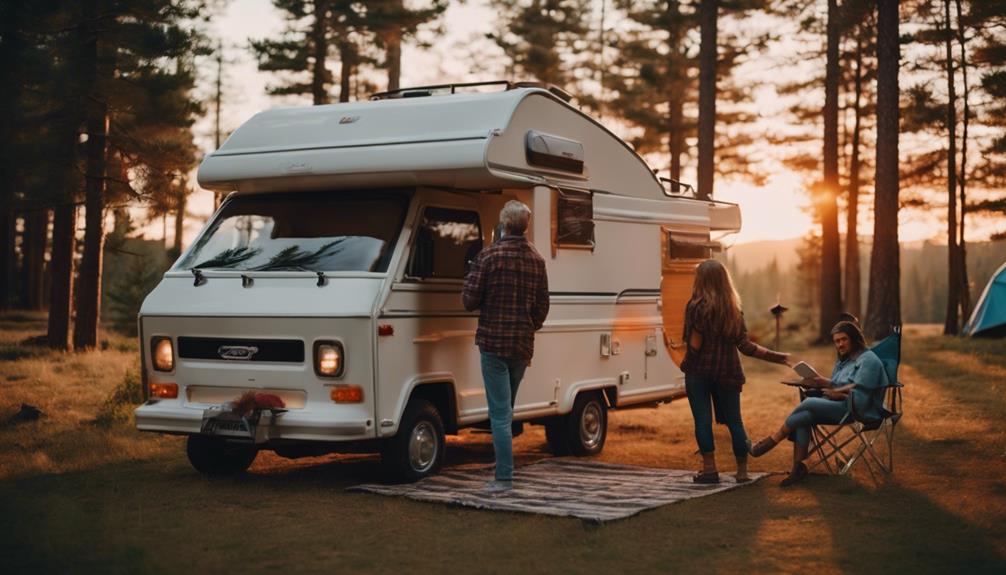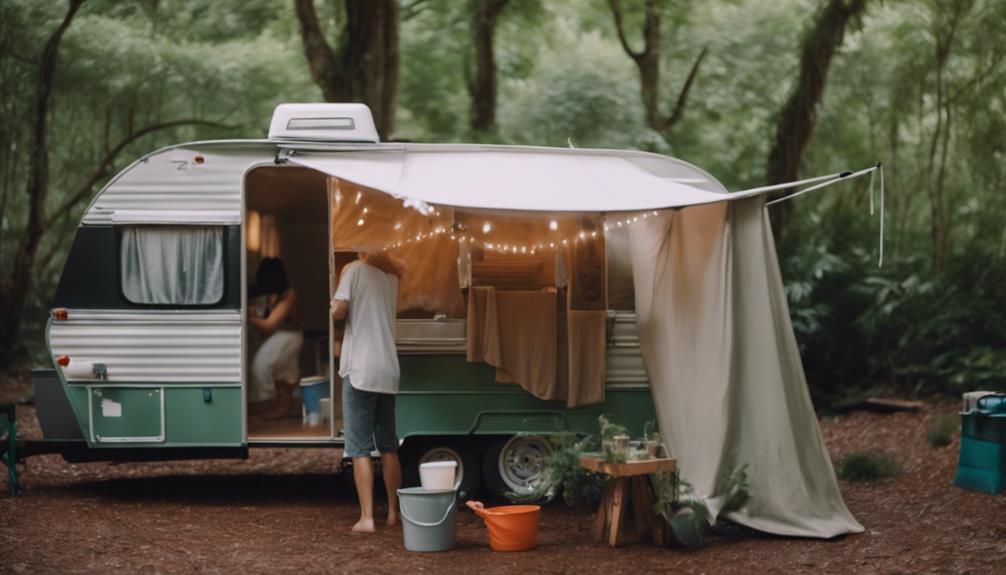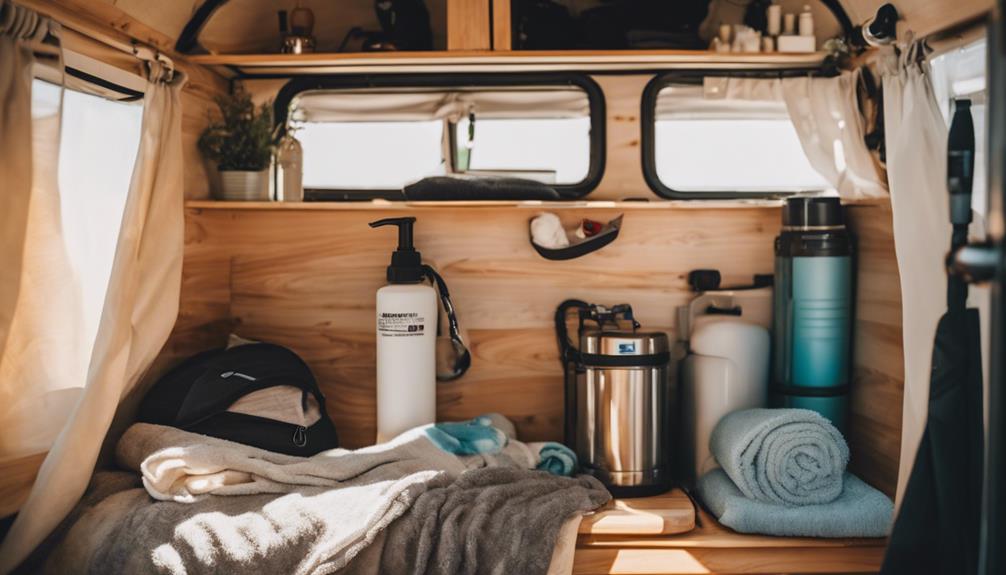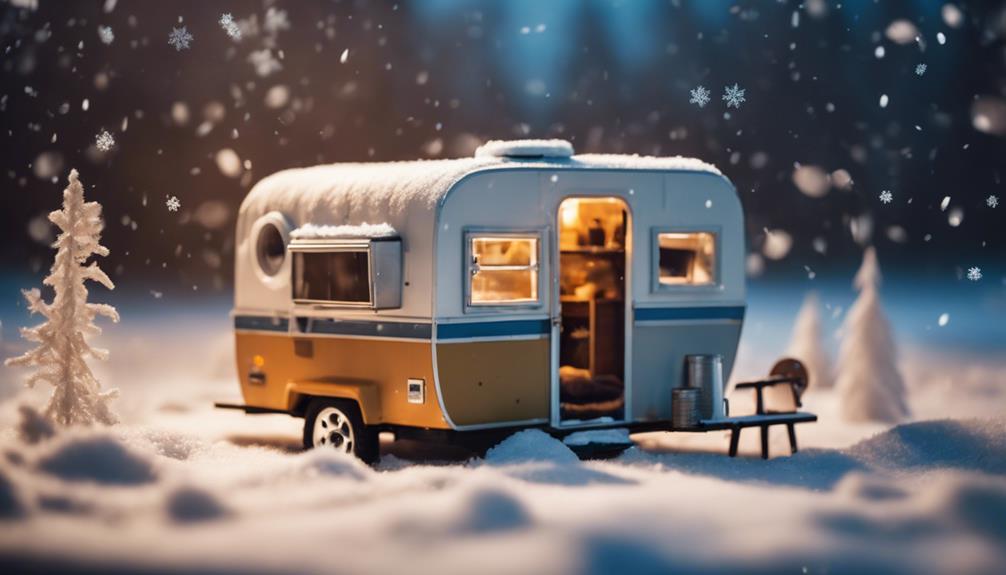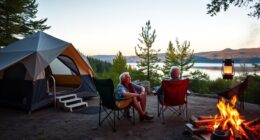Balancing your pop-up camper is essential for stability and comfort. Start by ensuring the camper is on a level surface; asphalt is ideal. Use leveling blocks to adjust tire height on uneven ground. Employ stabilizer jacks for extra side support and check weight distribution—keep heavy items low and near the axle. Regularly inspect your leveling equipment for wear to avoid any unexpected issues. Don't forget to secure everything inside; excessive movement can indicate leveling problems. With these tips, you'll enhance safety and relaxation on your trips. Discover other helpful strategies to make your camping experience even smoother.
Key Takeaways
- Use a BAL Leveler and stabilizer jacks to achieve quick and effective leveling for optimal camper performance and safety.
- Distribute weight evenly by placing heavy items low and near the axle to lower the camper's center of gravity.
- Assess ground surfaces; utilize leveling blocks on soft ground and wheel chocks on slopes to enhance stability.
- Regularly inspect leveling equipment, including stabilizer jacks and blocks, to ensure they are functional and free from damage.
Importance of Leveling
Leveling your pop-up camper is vital for ideal appliance performance and your overall comfort during your adventures. If you don't properly level your trailer, you might experience common issues like inefficient refrigeration or discomfort while sleeping. A level surface guarantees that your 3-way refrigerator operates correctly, preventing potential damage.
To stabilize the camper, you should always check it side to side first. This step helps avoid slanted sleeping positions that can lead to headaches and restless nights. When you're setting up for the first time, remember that inadequate leveling can put structural stress on the camper frame, negatively affecting its lifespan.
Taking the time to level your trailer not only enhances comfort but also improves stability and safety. An uneven camper can tip and lead to dangerous situations, so it's imperative to guarantee even weight distribution across the axles and wheels.
Essential Tools and Equipment
To balance your pop-up camper effectively, you'll need some essential tools and equipment.
A BAL Leveler, stabilizer jacks, and a reliable bubble level are key for achieving a secure setup.
Additionally, having leveling blocks and a Craftsman ratchet wrench can make your adjustments straightforward and efficient.
Required Leveling Tools
When setting up your pop-up camper, having the right leveling tools is vital for guaranteeing a stable and comfortable experience.
Start with a BAL Leveler for quick adjustments; it helps you level the trailer efficiently. Use tongue jacks to achieve front-to-back leveling, making sure the camper sits evenly on the ground. For side support during parking, stabilizer jacks are a must—they provide extra stability once you've found your spot.
Graduated bubble levels with adhesive strips are invaluable for visual checks. They give you accurate indicators from multiple angles, making leveling easier. If you're parked on uneven surfaces, leveling blocks are important for raising tires, allowing for better weight distribution and stability.
To make precise adjustments to your leveling equipment, a Craftsman ratchet wrench is recommended. This tool guarantees that everything is secure, giving you peace of mind while you enjoy your camping trip.
Stabilization Equipment Options
Stabilization equipment options, like BAL Levelers and stabilizer jacks, are essential for guaranteeing your pop-up camper remains steady and secure during your outdoor adventures.
Here are three key tools to take into account:
- BAL Levelers: These make leveling quick and effective, assuring your camper is balanced for safety and comfort.
- Stabilizer Jacks: Properly deploying these after raising the roof provides side-to-side support, minimizing movement and stress on your camper's frame.
- Leveling Blocks or Pads: Use these to adjust the height of your tires on uneven ground, enhancing stability and preventing tipping.
Don't forget to use a bubble level to accurately assess your camper level from multiple angles.
Investing in high-quality products, such as Andersen Levelers, can greatly improve your leveling efficiency and camping experience.
Remember, stability and comfort are key to enjoying your time outdoors, so take the time to set up properly.
With the right equipment and techniques, you can guarantee a safe and relaxing camping experience, no matter where you pitch your tent!
Common Leveling Challenges

Facing common leveling challenges can greatly impact your pop-up camper's stability and comfort, making it vital to address these issues promptly. One of the most significant challenges is dealing with uneven ground surfaces. These surfaces can lead to an unstable camper, increasing the risk of tipping or swaying. When setting up, verify your leveling system is functioning correctly and that you properly use stabilizers to keep your camper steady.
Ground softness can complicate things further, as stabilizers may sink over time, resulting in inadequate support. To combat this, consider using leveling pads or blocks to enhance weight distribution. Additionally, keep an eye on weight imbalance; poorly distributed cargo can disrupt your camper's stability.
Regular inspection of your leveling equipment, including stabilizers and jacks, is essential to prevent these common issues. If you notice excessive movement inside your camper, it's a sign that something's not right. Address these leveling challenges head-on to guarantee a comfortable and safe camping experience every time you hit the road.
Maintenance Tips for Stability
To keep your pop-up camper stable, regular equipment checks are key.
You'll want to pay attention to weight distribution techniques and assess the surface conditions where you park.
Regular Equipment Checks
Regular equipment checks are essential for guaranteeing your pop-up camper remains stable and safe during your adventures. By keeping an eye on your equipment, you can avoid unexpected issues and enjoy your trips with peace of mind.
Here are three key items to focus on:
- Stabilizer Jacks: Regularly inspect these for wear and tear. Confirm they're operating efficiently to provide the necessary support.
- Leveling Blocks: Check the condition of your leveling blocks before each trip. Replace any that show signs of cracking or significant wear to prevent failure during use.
- Leveling Tools: Verify that all leveling tools, including tongue jacks and devices like the BAL Leveler, are functioning properly.
Consult your owner's manual for specific maintenance schedules to keep everything in prime condition.
It's also wise to periodically assess the lift cables and mechanisms for fraying or damage. These components are critical for the safe operation of your pop-up camper.
Weight Distribution Techniques
Maintaining stability in your pop-up camper goes beyond equipment checks; it also involves mastering weight distribution techniques to guarantee a safe and balanced ride. Proper weight distribution is essential, so place heavy items low and near the axle to maintain a low center of gravity. This strategy helps prevent tipping while driving.
Regularly check and adjust your cargo placement, as any changes in weight can impact the camper's center of gravity and overall stability. Utilize weigh stations to monitor distribution across axles, ensuring you stay within weight limits and improve handling.
Managing water tank levels is another important aspect of weight distribution. When tanks are full, they can greatly affect your camper's balance, so plan accordingly. Aim for equal weight distribution on both sides of the camper to minimize swaying and enhance safety during travel and while parked.
Surface Condition Assessment
Evaluating the ground surface before setting up your pop-up camper is essential for guaranteeing stability and preventing issues during your stay. Here are three key considerations to keep in mind:
- Surface Type: Different surfaces (dirt, sand, gravel, asphalt) provide varying levels of support. Aim for asphalt when possible, as it offers the finest stability.
- Leveling Pads: Always use leveling pads or blocks under your stabilizers, especially on soft ground. This helps prevent sinking and promotes better weight distribution.
- Wheel Chocks: Place wheel chocks on both sides of the camper. This minimizes lateral movement and enhances overall stability.
Keep an eye on the surface condition, as uneven surfaces can hinder the performance of your stabilizers. Adjust their position and height to maintain ideal camper balance.
Regularly inspect your stabilizers and jacks for wear and tear; damaged equipment can compromise stability and lead to movement within the camper.
Ground Surface Considerations

The type of ground surface you choose for your pop-up camper plays an important role in guaranteeing its stability and safety. Asphalt is your best bet for support, while softer surfaces like dirt, sand, or gravel can lead to instability. When parked on soft ground, stabilizers might sink over time, so it's essential to use leveling pads or blocks. These will help distribute weight evenly and prevent sinking.
If you find yourself on uneven terrain, assess the ground conditions before setting up. Adjust your camper's position as needed to maintain ideal stability. Additionally, using wheel chocks on both sides of the camper can greatly enhance stability, especially on sloped surfaces. These chocks will help prevent back-and-forth movement once you're parked.
Regular inspection of your stabilizers and supports is critical too. Different ground surfaces can cause wear and tear, impacting their effectiveness. By keeping an eye on these components, you can guarantee your pop-up camper remains stable regardless of where you set up camp.
Prioritize the ground surface you choose—it's key to enjoying a safe and comfortable camping experience.
User Experiences and Solutions
Many campers share valuable insights and creative solutions that can help you tackle common leveling and stabilization challenges. Here are three key methods you might find useful:
- Use a BAL Leveler: Many users report that this tool considerably reduces setup and level time, minimizing disputes related to leveling your camper.
- Stacking Leveling Pads: This is especially effective on soft ground, enhancing stability. Regular adjustments based on ground conditions can make a big difference.
- Engage with the Camping Community: By connecting with fellow campers, you can discover DIY stabilizer solutions and custom stabilizer setups tailored to your needs.
When you're leveling your camper, aim for a solid surface to avoid poor drainage and guarantee comfort.
Some campers even suggest swapping sleeping arrangements to find the desired height and minimize movement.
These shared experiences not only provide practical advice but also foster a sense of camaraderie among campers.
Whether you're a newbie or seasoned pro, implementing these tips can enhance your camping trips, making them more enjoyable and stable.
Community Resources and Support

How can connecting with community resources enhance your experience in leveling and stabilizing your pop-up camper?
Engaging with online forums, like PopUpPortal, allows you to tap into a wealth of knowledge. You can share tips and troubleshoot issues related to stabilizing techniques with fellow campers who've faced similar challenges.
Subscribing to RV living podcasts or blogs offers valuable insights into equipment usage and the latest tips and tricks for balancing your camper effectively.
Joining social media groups focused on camping provides a space for you to ask questions and gather solutions, ensuring you gain a well-rounded understanding of stabilization methods.
YouTube instructional videos can be particularly helpful, as they visually demonstrate DIY stabilization methods that you can implement.
Additionally, participating in local camping clubs can foster community support, giving you the chance to learn hands-on from experienced pop-up camper owners.
Frequently Asked Questions
How to Make a Pop-Up Camper More Stable?
To make your pop-up camper more stable, use stabilizer jacks at all corners, place leveling blocks under them, and add wheel chocks. Regularly inspect your equipment to verify everything's in good working order.
How to Balance a Pop-Up Camper?
Balancing a pop-up camper's like trying to hold a mountain on a toothpick! You'll want to guarantee weight's evenly distributed, use leveling blocks, and deploy stabilizer jacks for a solid, comfortable setup.
How to Properly Level a Pop-Up Camper?
To properly level a pop-up camper, park on level ground, use a bubble level for adjustments, and deploy stabilizers after raising the roof. Regularly check your equipment to maintain ideal functionality and stability.
Why Is My Pop-Up Camper Leaning to One Side?
Your pop-up camper might be leaning due to uneven ground, improper weight distribution, or unadjusted stabilizer jacks. Check these factors to restore balance, ensuring a stable and comfortable camping experience.
Can Attaching an Awning to a Pop-Up Camper Affect its Balance and Stability?
Yes, attaching an awning to a pop-up camper can affect its balance and stability. The added weight and wind resistance can alter the way the camper tows and handles. It’s important to consider the potential impact and make any necessary adjustments to ensure safe and secure travel with an attach awning to camper.
Can Properly Storing a Pop-Up Camper Help Maintain Balance and Stability?
Properly storing a pop-up camper can significantly help maintain balance and stability on the road. Following some important tips for storing popup camper, such as evenly distributing weight, keeping tires properly inflated, and securing items inside the camper, can make a big difference in the overall stability of the vehicle.
Conclusion
By leveling your pop-up camper, you're not just ensuring stability; you're creating a cozy sanctuary amidst nature's wonders.
With the right tools and a little know-how, you can tackle common challenges and enjoy a smoother camping experience.
Remember, a well-balanced camper is like a ship sailing smoothly on calm seas—both safe and inviting.
So grab those leveling blocks, and get ready to embrace the great outdoors with confidence and comfort!



